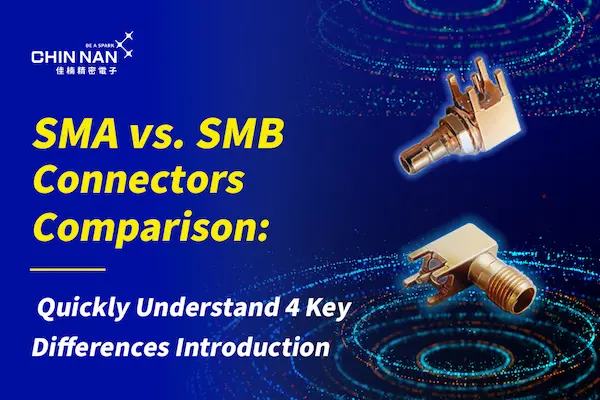SMA vs. SMB Connectors Comparison: Quickly Understand 4 Key Differences

SMA vs. SMB Connectors Comparison: Quickly Understand 4 Key Differences
Introduction
In RF applications, choosing the right connector is crucial for system performance. The SMA and SMB connectors are two common RF connectors that, although their names are similar, have different design characteristics and application scenarios. This article will provide an in-depth comparison of their performance to help you make an informed decision based on your specific needs.
Basic Introduction to SMA and SMB Connectors
SMA Connector:
The SMA (SubMiniature A) connector is an RF connector with a threaded coupling that is known for its high precision and stability. Its applications include communication, navigation, and testing equipment for high-frequency demands.
SMB Connector:
The SMB (SubMiniature B) connector is a compact RF connector widely used in high-frequency signal transmission scenarios. It is designed for miniaturization and lightweight, offering the convenience of quick connection and disconnection.
Performance Comparison of SMA and SMB Connectors
1. Electrical Performance
- Operating Frequency Range: SMA connectors support frequencies up to 18 GHz and even higher. SMB connectors typically support frequencies up to 4 GHz. If your application requires frequencies above 4 GHz, the SMA connector is more suitable for your needs.
- Insertion Loss: SMA connectors have lower insertion loss due to their precise design, making them ideal for high-frequency applications that are sensitive to signal loss.
- Return Loss: SMA connectors perform better in terms of return loss, offering better impedance matching than SMB connectors.
2. Mechanical Performance
- Connection Type: SMB connectors use a push-in design for quick connections and disconnections, while SMA connectors utilize a threaded coupling, providing a more secure connection.
- Insertion/Removal Life: SMB connectors are suited for medium-frequency insertion and removal operations, while SMA connectors are more durable and designed for high-frequency applications requiring frequent engagement.
3. Size and Weight
- SMB connectors are smaller and lighter, making them ideal for applications with space and weight constraints. On the other hand, SMA connectors are larger but offer better structural stability.
4. Application Scenarios
- SMB Connectors: Best for small RF devices requiring quick insertion and removal, such as mobile devices, medical equipment, and small communication systems.
- SMA Connectors: Better suited for high-frequency transmission and stable applications, such as radar, wireless communication base stations, and RF test equipment.
How to Choose the Right RF Connector?
When selecting between SMA and SMB connectors, consider the following factors:
- Frequency Requirements: If your application requires frequencies above 4 GHz, opt for SMA connectors.
- Connection Convenience: For scenarios requiring fast operation, SMB connectors are the better choice.
- Space Constraints: For devices with strict size limitations, SMB connectors have an advantage.
- Stability Needs: For high-stability applications such as test equipment or navigation systems, SMA connectors should be selected.
Conclusion
Both SMA and SMB connectors have distinct performance features and application scenarios. When choosing, balance the frequency, connection type, size requirements, and stability needs based on your specific application. This article aims to provide valuable guidance to engineers and procurement professionals, helping you select the best RF solution.
Explore CHIN NAN's SMB Connectors Now—Stable Performance and Durable Design to Meet Your Critical Needs!
Have Any Connector Needs? Contact CHIN NAN's Professional Team Now (service@chinnan.com.tw) for Exclusive Technical Assistance!
Related Articles You May Like: "SMA vs. N-Type RF Connector Comparison"



















